NZDB 605 Assignment 1: Change Management and Kiwibank Analysis
VerifiedAdded on 2022/10/19
|23
|6557
|463
Report
AI Summary
This report provides a comprehensive analysis of change management and leadership within Kiwibank, a New Zealand-based bank. The report begins with an executive summary and an introduction to Kiwibank, highlighting its mission, vision, and strategic objectives. It then delves into the core of change management, defining its purpose and types, and identifying key issues and challenges faced by Kiwibank, including restructuring and IT system upgrades. The report applies the change management life cycle model to Kiwibank's situation, detailing each phase. A critical analysis of three change management models—Kotter's eight-step process, Lewin's Change Management Model, and the ADKAR Model—is provided, recommending the most suitable model for Kiwibank. The report further explores change implementation, addressing resistance to change and outlining organizational management strategies, including a communication plan and the crucial role of a change agent. Leadership styles, including Kurt Lewin’s styles and transformational change, are examined in relation to organizational culture. Finally, the report concludes by summarizing the key findings and emphasizing the successful application of change management strategies in overcoming Kiwibank's challenges. The report references the NZDB 605 curriculum, indicating that it is an assignment for the New Zealand Diploma in Business (Leadership and Management) Level 6 course.

Change management and leadership
Paraphrase This Document
Need a fresh take? Get an instant paraphrase of this document with our AI Paraphraser
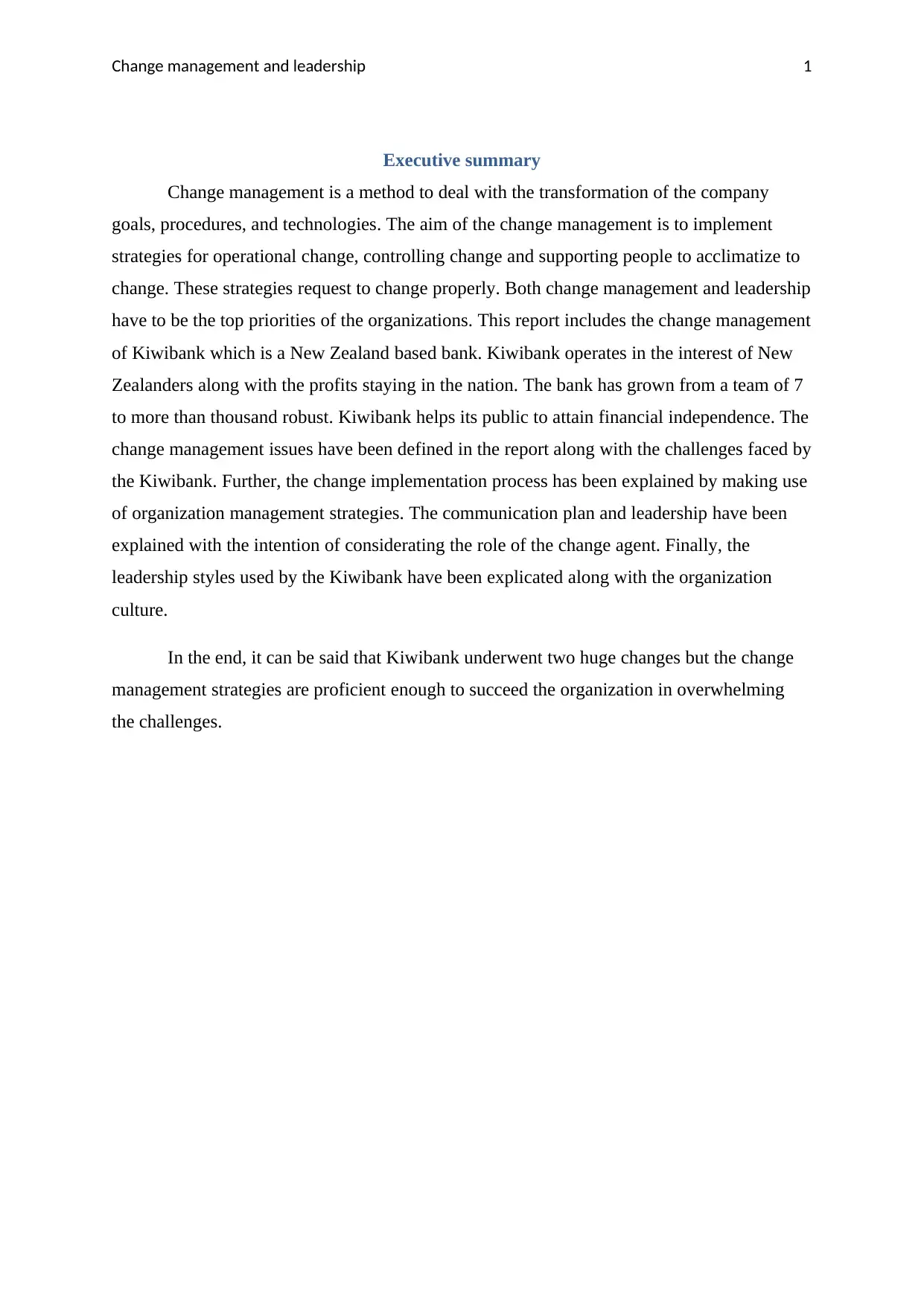
Change management and leadership 1
Executive summary
Change management is a method to deal with the transformation of the company
goals, procedures, and technologies. The aim of the change management is to implement
strategies for operational change, controlling change and supporting people to acclimatize to
change. These strategies request to change properly. Both change management and leadership
have to be the top priorities of the organizations. This report includes the change management
of Kiwibank which is a New Zealand based bank. Kiwibank operates in the interest of New
Zealanders along with the profits staying in the nation. The bank has grown from a team of 7
to more than thousand robust. Kiwibank helps its public to attain financial independence. The
change management issues have been defined in the report along with the challenges faced by
the Kiwibank. Further, the change implementation process has been explained by making use
of organization management strategies. The communication plan and leadership have been
explained with the intention of considerating the role of the change agent. Finally, the
leadership styles used by the Kiwibank have been explicated along with the organization
culture.
In the end, it can be said that Kiwibank underwent two huge changes but the change
management strategies are proficient enough to succeed the organization in overwhelming
the challenges.
Executive summary
Change management is a method to deal with the transformation of the company
goals, procedures, and technologies. The aim of the change management is to implement
strategies for operational change, controlling change and supporting people to acclimatize to
change. These strategies request to change properly. Both change management and leadership
have to be the top priorities of the organizations. This report includes the change management
of Kiwibank which is a New Zealand based bank. Kiwibank operates in the interest of New
Zealanders along with the profits staying in the nation. The bank has grown from a team of 7
to more than thousand robust. Kiwibank helps its public to attain financial independence. The
change management issues have been defined in the report along with the challenges faced by
the Kiwibank. Further, the change implementation process has been explained by making use
of organization management strategies. The communication plan and leadership have been
explained with the intention of considerating the role of the change agent. Finally, the
leadership styles used by the Kiwibank have been explicated along with the organization
culture.
In the end, it can be said that Kiwibank underwent two huge changes but the change
management strategies are proficient enough to succeed the organization in overwhelming
the challenges.
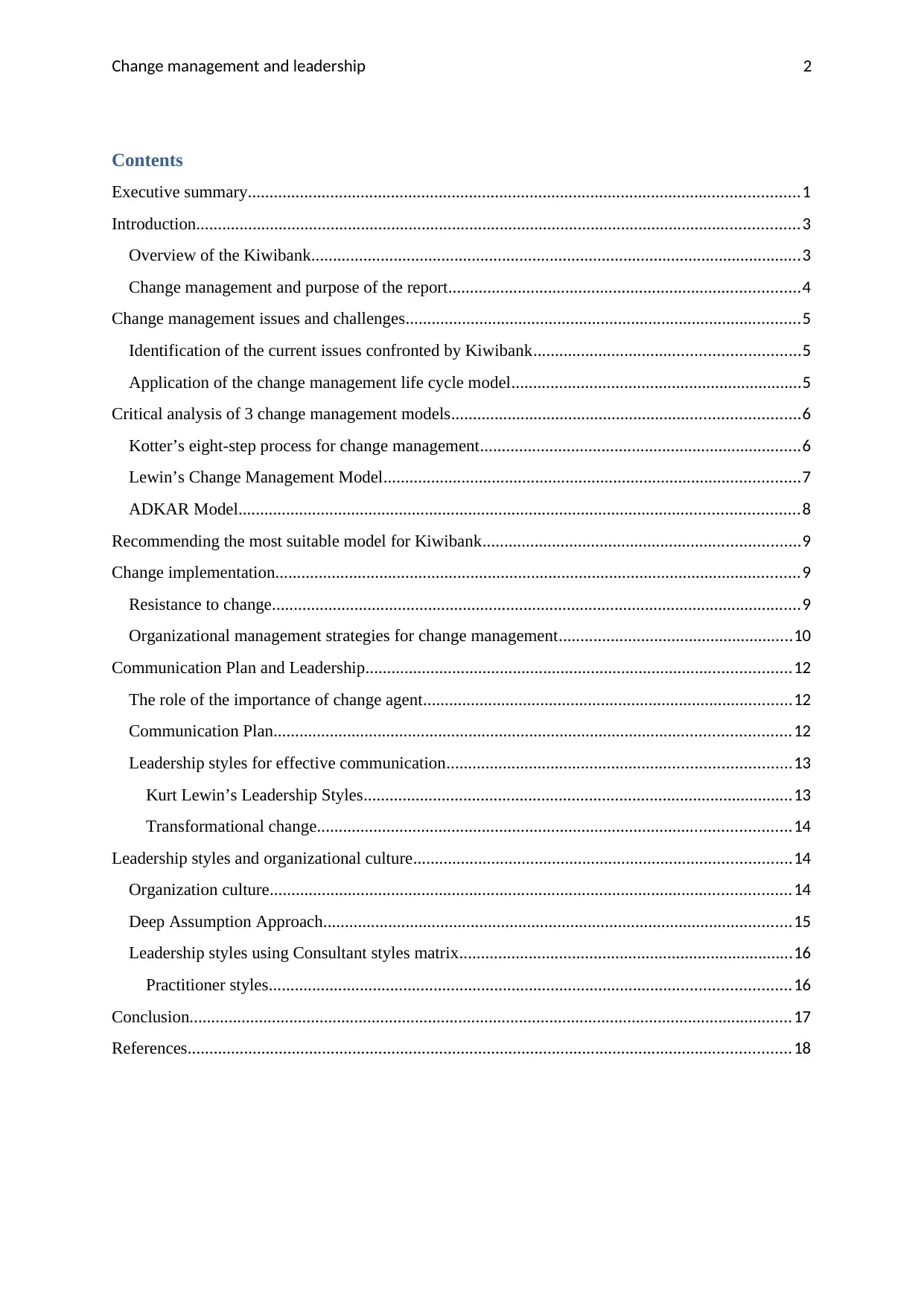
Change management and leadership 2
Contents
Executive summary...............................................................................................................................1
Introduction...........................................................................................................................................3
Overview of the Kiwibank.................................................................................................................3
Change management and purpose of the report.................................................................................4
Change management issues and challenges...........................................................................................5
Identification of the current issues confronted by Kiwibank.............................................................5
Application of the change management life cycle model...................................................................5
Critical analysis of 3 change management models................................................................................6
Kotter’s eight-step process for change management..........................................................................6
Lewin’s Change Management Model................................................................................................7
ADKAR Model.................................................................................................................................8
Recommending the most suitable model for Kiwibank.........................................................................9
Change implementation.........................................................................................................................9
Resistance to change..........................................................................................................................9
Organizational management strategies for change management......................................................10
Communication Plan and Leadership..................................................................................................12
The role of the importance of change agent.....................................................................................12
Communication Plan.......................................................................................................................12
Leadership styles for effective communication...............................................................................13
Kurt Lewin’s Leadership Styles...................................................................................................13
Transformational change.............................................................................................................14
Leadership styles and organizational culture.......................................................................................14
Organization culture........................................................................................................................14
Deep Assumption Approach............................................................................................................15
Leadership styles using Consultant styles matrix.............................................................................16
Practitioner styles........................................................................................................................16
Conclusion...........................................................................................................................................17
References...........................................................................................................................................18
Contents
Executive summary...............................................................................................................................1
Introduction...........................................................................................................................................3
Overview of the Kiwibank.................................................................................................................3
Change management and purpose of the report.................................................................................4
Change management issues and challenges...........................................................................................5
Identification of the current issues confronted by Kiwibank.............................................................5
Application of the change management life cycle model...................................................................5
Critical analysis of 3 change management models................................................................................6
Kotter’s eight-step process for change management..........................................................................6
Lewin’s Change Management Model................................................................................................7
ADKAR Model.................................................................................................................................8
Recommending the most suitable model for Kiwibank.........................................................................9
Change implementation.........................................................................................................................9
Resistance to change..........................................................................................................................9
Organizational management strategies for change management......................................................10
Communication Plan and Leadership..................................................................................................12
The role of the importance of change agent.....................................................................................12
Communication Plan.......................................................................................................................12
Leadership styles for effective communication...............................................................................13
Kurt Lewin’s Leadership Styles...................................................................................................13
Transformational change.............................................................................................................14
Leadership styles and organizational culture.......................................................................................14
Organization culture........................................................................................................................14
Deep Assumption Approach............................................................................................................15
Leadership styles using Consultant styles matrix.............................................................................16
Practitioner styles........................................................................................................................16
Conclusion...........................................................................................................................................17
References...........................................................................................................................................18
⊘ This is a preview!⊘
Do you want full access?
Subscribe today to unlock all pages.

Trusted by 1+ million students worldwide
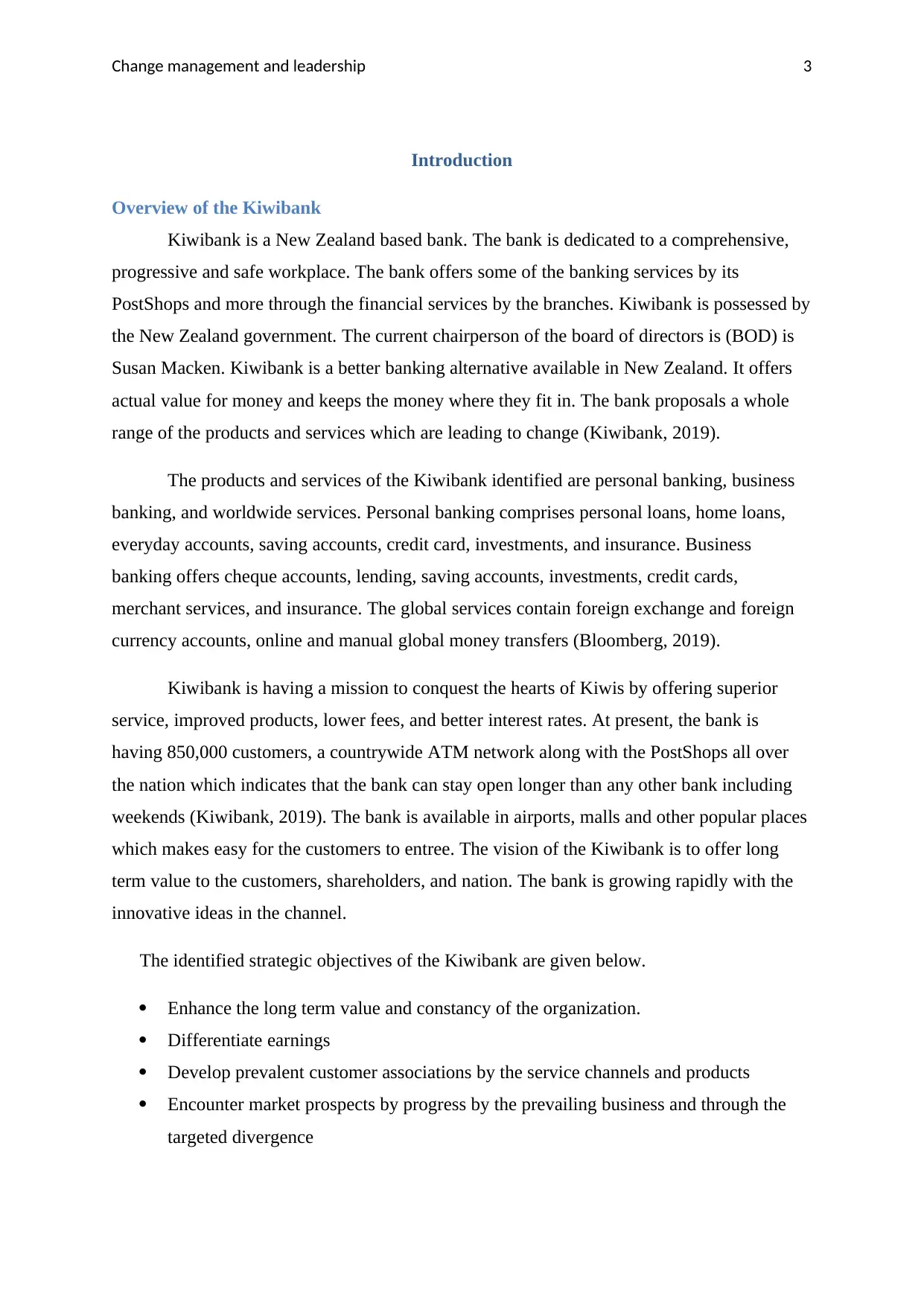
Change management and leadership 3
Introduction
Overview of the Kiwibank
Kiwibank is a New Zealand based bank. The bank is dedicated to a comprehensive,
progressive and safe workplace. The bank offers some of the banking services by its
PostShops and more through the financial services by the branches. Kiwibank is possessed by
the New Zealand government. The current chairperson of the board of directors is (BOD) is
Susan Macken. Kiwibank is a better banking alternative available in New Zealand. It offers
actual value for money and keeps the money where they fit in. The bank proposals a whole
range of the products and services which are leading to change (Kiwibank, 2019).
The products and services of the Kiwibank identified are personal banking, business
banking, and worldwide services. Personal banking comprises personal loans, home loans,
everyday accounts, saving accounts, credit card, investments, and insurance. Business
banking offers cheque accounts, lending, saving accounts, investments, credit cards,
merchant services, and insurance. The global services contain foreign exchange and foreign
currency accounts, online and manual global money transfers (Bloomberg, 2019).
Kiwibank is having a mission to conquest the hearts of Kiwis by offering superior
service, improved products, lower fees, and better interest rates. At present, the bank is
having 850,000 customers, a countrywide ATM network along with the PostShops all over
the nation which indicates that the bank can stay open longer than any other bank including
weekends (Kiwibank, 2019). The bank is available in airports, malls and other popular places
which makes easy for the customers to entree. The vision of the Kiwibank is to offer long
term value to the customers, shareholders, and nation. The bank is growing rapidly with the
innovative ideas in the channel.
The identified strategic objectives of the Kiwibank are given below.
Enhance the long term value and constancy of the organization.
Differentiate earnings
Develop prevalent customer associations by the service channels and products
Encounter market prospects by progress by the prevailing business and through the
targeted divergence
Introduction
Overview of the Kiwibank
Kiwibank is a New Zealand based bank. The bank is dedicated to a comprehensive,
progressive and safe workplace. The bank offers some of the banking services by its
PostShops and more through the financial services by the branches. Kiwibank is possessed by
the New Zealand government. The current chairperson of the board of directors is (BOD) is
Susan Macken. Kiwibank is a better banking alternative available in New Zealand. It offers
actual value for money and keeps the money where they fit in. The bank proposals a whole
range of the products and services which are leading to change (Kiwibank, 2019).
The products and services of the Kiwibank identified are personal banking, business
banking, and worldwide services. Personal banking comprises personal loans, home loans,
everyday accounts, saving accounts, credit card, investments, and insurance. Business
banking offers cheque accounts, lending, saving accounts, investments, credit cards,
merchant services, and insurance. The global services contain foreign exchange and foreign
currency accounts, online and manual global money transfers (Bloomberg, 2019).
Kiwibank is having a mission to conquest the hearts of Kiwis by offering superior
service, improved products, lower fees, and better interest rates. At present, the bank is
having 850,000 customers, a countrywide ATM network along with the PostShops all over
the nation which indicates that the bank can stay open longer than any other bank including
weekends (Kiwibank, 2019). The bank is available in airports, malls and other popular places
which makes easy for the customers to entree. The vision of the Kiwibank is to offer long
term value to the customers, shareholders, and nation. The bank is growing rapidly with the
innovative ideas in the channel.
The identified strategic objectives of the Kiwibank are given below.
Enhance the long term value and constancy of the organization.
Differentiate earnings
Develop prevalent customer associations by the service channels and products
Encounter market prospects by progress by the prevailing business and through the
targeted divergence
Paraphrase This Document
Need a fresh take? Get an instant paraphrase of this document with our AI Paraphraser
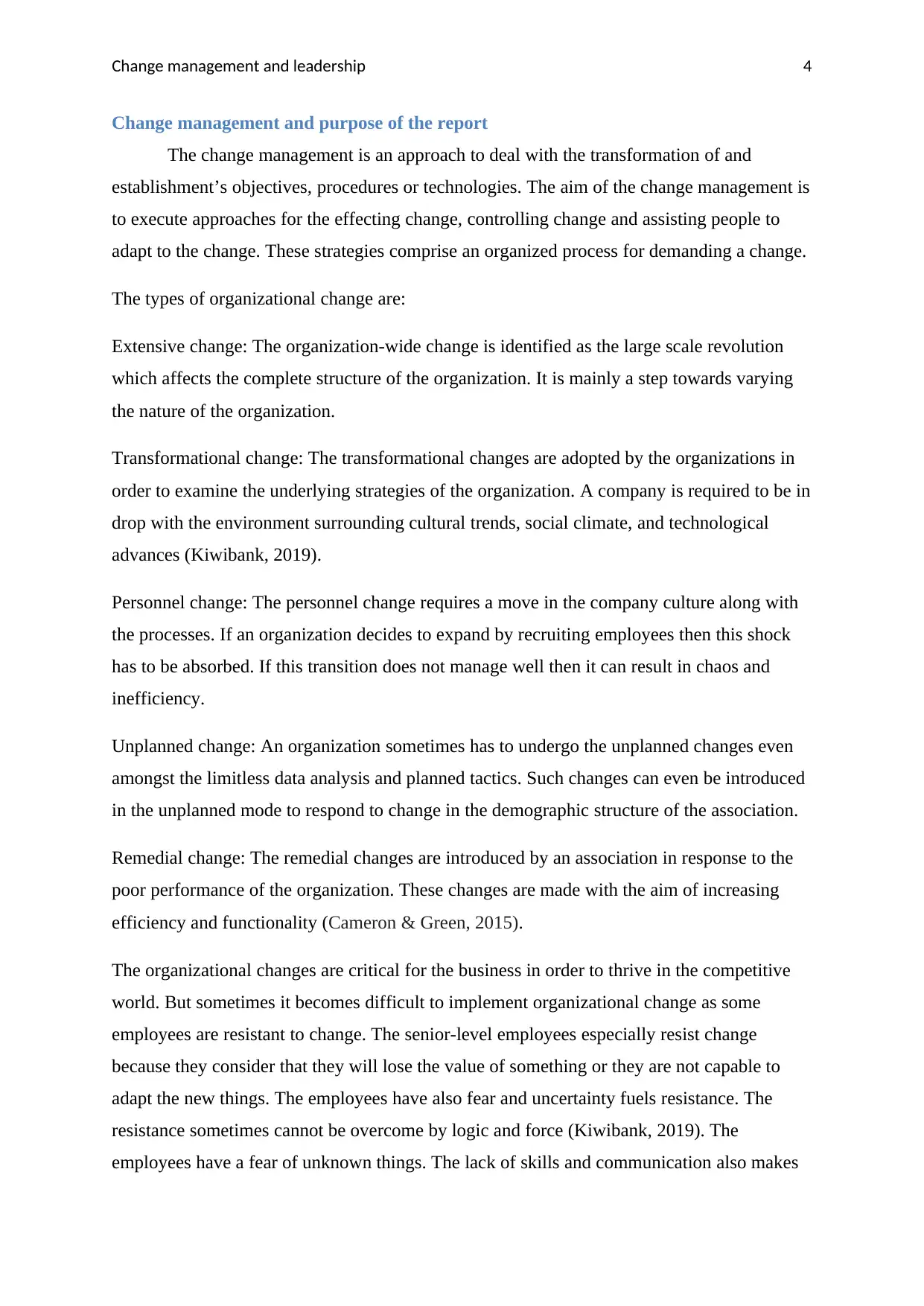
Change management and leadership 4
Change management and purpose of the report
The change management is an approach to deal with the transformation of and
establishment’s objectives, procedures or technologies. The aim of the change management is
to execute approaches for the effecting change, controlling change and assisting people to
adapt to the change. These strategies comprise an organized process for demanding a change.
The types of organizational change are:
Extensive change: The organization-wide change is identified as the large scale revolution
which affects the complete structure of the organization. It is mainly a step towards varying
the nature of the organization.
Transformational change: The transformational changes are adopted by the organizations in
order to examine the underlying strategies of the organization. A company is required to be in
drop with the environment surrounding cultural trends, social climate, and technological
advances (Kiwibank, 2019).
Personnel change: The personnel change requires a move in the company culture along with
the processes. If an organization decides to expand by recruiting employees then this shock
has to be absorbed. If this transition does not manage well then it can result in chaos and
inefficiency.
Unplanned change: An organization sometimes has to undergo the unplanned changes even
amongst the limitless data analysis and planned tactics. Such changes can even be introduced
in the unplanned mode to respond to change in the demographic structure of the association.
Remedial change: The remedial changes are introduced by an association in response to the
poor performance of the organization. These changes are made with the aim of increasing
efficiency and functionality (Cameron & Green, 2015).
The organizational changes are critical for the business in order to thrive in the competitive
world. But sometimes it becomes difficult to implement organizational change as some
employees are resistant to change. The senior-level employees especially resist change
because they consider that they will lose the value of something or they are not capable to
adapt the new things. The employees have also fear and uncertainty fuels resistance. The
resistance sometimes cannot be overcome by logic and force (Kiwibank, 2019). The
employees have a fear of unknown things. The lack of skills and communication also makes
Change management and purpose of the report
The change management is an approach to deal with the transformation of and
establishment’s objectives, procedures or technologies. The aim of the change management is
to execute approaches for the effecting change, controlling change and assisting people to
adapt to the change. These strategies comprise an organized process for demanding a change.
The types of organizational change are:
Extensive change: The organization-wide change is identified as the large scale revolution
which affects the complete structure of the organization. It is mainly a step towards varying
the nature of the organization.
Transformational change: The transformational changes are adopted by the organizations in
order to examine the underlying strategies of the organization. A company is required to be in
drop with the environment surrounding cultural trends, social climate, and technological
advances (Kiwibank, 2019).
Personnel change: The personnel change requires a move in the company culture along with
the processes. If an organization decides to expand by recruiting employees then this shock
has to be absorbed. If this transition does not manage well then it can result in chaos and
inefficiency.
Unplanned change: An organization sometimes has to undergo the unplanned changes even
amongst the limitless data analysis and planned tactics. Such changes can even be introduced
in the unplanned mode to respond to change in the demographic structure of the association.
Remedial change: The remedial changes are introduced by an association in response to the
poor performance of the organization. These changes are made with the aim of increasing
efficiency and functionality (Cameron & Green, 2015).
The organizational changes are critical for the business in order to thrive in the competitive
world. But sometimes it becomes difficult to implement organizational change as some
employees are resistant to change. The senior-level employees especially resist change
because they consider that they will lose the value of something or they are not capable to
adapt the new things. The employees have also fear and uncertainty fuels resistance. The
resistance sometimes cannot be overcome by logic and force (Kiwibank, 2019). The
employees have a fear of unknown things. The lack of skills and communication also makes
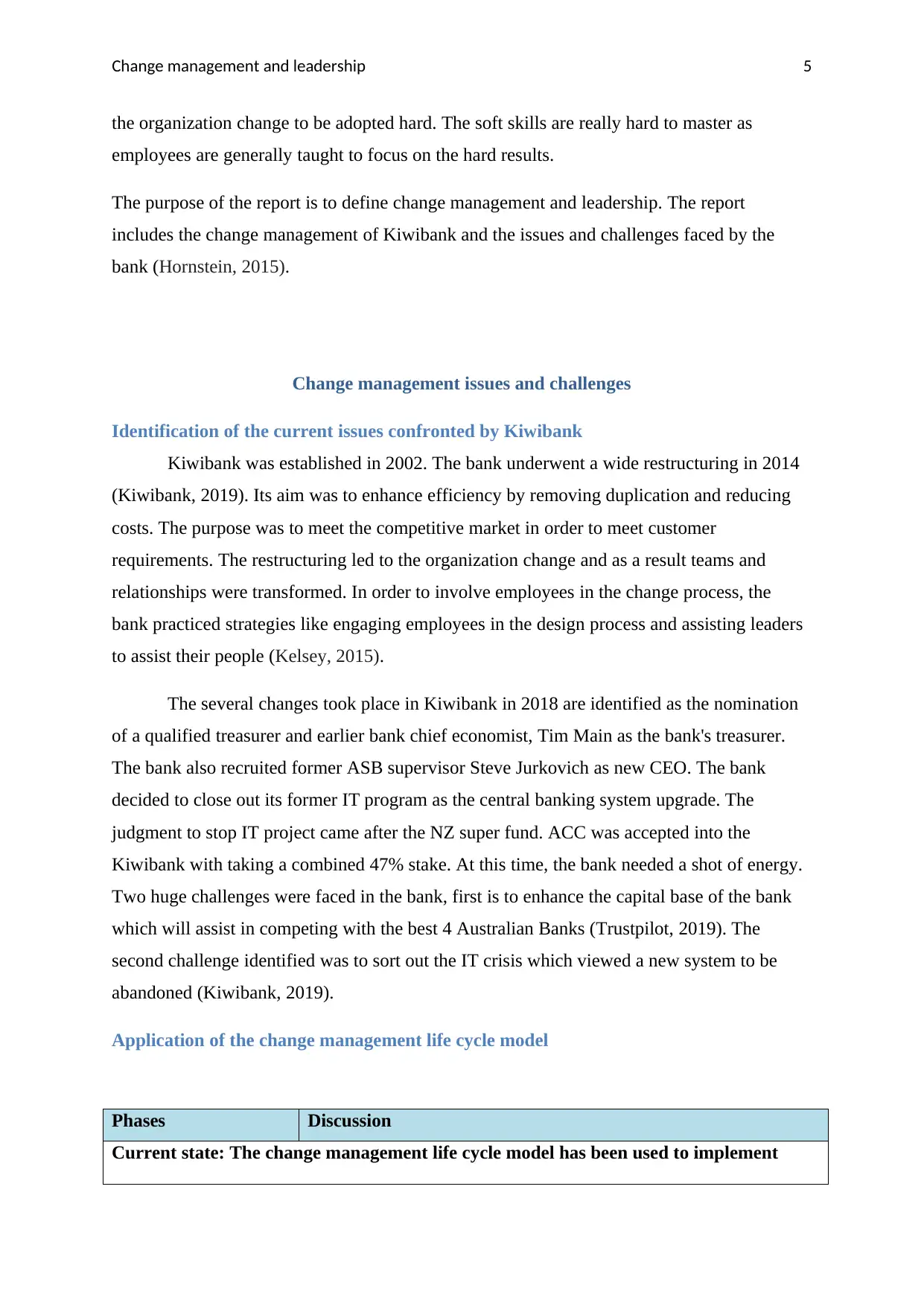
Change management and leadership 5
the organization change to be adopted hard. The soft skills are really hard to master as
employees are generally taught to focus on the hard results.
The purpose of the report is to define change management and leadership. The report
includes the change management of Kiwibank and the issues and challenges faced by the
bank (Hornstein, 2015).
Change management issues and challenges
Identification of the current issues confronted by Kiwibank
Kiwibank was established in 2002. The bank underwent a wide restructuring in 2014
(Kiwibank, 2019). Its aim was to enhance efficiency by removing duplication and reducing
costs. The purpose was to meet the competitive market in order to meet customer
requirements. The restructuring led to the organization change and as a result teams and
relationships were transformed. In order to involve employees in the change process, the
bank practiced strategies like engaging employees in the design process and assisting leaders
to assist their people (Kelsey, 2015).
The several changes took place in Kiwibank in 2018 are identified as the nomination
of a qualified treasurer and earlier bank chief economist, Tim Main as the bank's treasurer.
The bank also recruited former ASB supervisor Steve Jurkovich as new CEO. The bank
decided to close out its former IT program as the central banking system upgrade. The
judgment to stop IT project came after the NZ super fund. ACC was accepted into the
Kiwibank with taking a combined 47% stake. At this time, the bank needed a shot of energy.
Two huge challenges were faced in the bank, first is to enhance the capital base of the bank
which will assist in competing with the best 4 Australian Banks (Trustpilot, 2019). The
second challenge identified was to sort out the IT crisis which viewed a new system to be
abandoned (Kiwibank, 2019).
Application of the change management life cycle model
Phases Discussion
Current state: The change management life cycle model has been used to implement
the organization change to be adopted hard. The soft skills are really hard to master as
employees are generally taught to focus on the hard results.
The purpose of the report is to define change management and leadership. The report
includes the change management of Kiwibank and the issues and challenges faced by the
bank (Hornstein, 2015).
Change management issues and challenges
Identification of the current issues confronted by Kiwibank
Kiwibank was established in 2002. The bank underwent a wide restructuring in 2014
(Kiwibank, 2019). Its aim was to enhance efficiency by removing duplication and reducing
costs. The purpose was to meet the competitive market in order to meet customer
requirements. The restructuring led to the organization change and as a result teams and
relationships were transformed. In order to involve employees in the change process, the
bank practiced strategies like engaging employees in the design process and assisting leaders
to assist their people (Kelsey, 2015).
The several changes took place in Kiwibank in 2018 are identified as the nomination
of a qualified treasurer and earlier bank chief economist, Tim Main as the bank's treasurer.
The bank also recruited former ASB supervisor Steve Jurkovich as new CEO. The bank
decided to close out its former IT program as the central banking system upgrade. The
judgment to stop IT project came after the NZ super fund. ACC was accepted into the
Kiwibank with taking a combined 47% stake. At this time, the bank needed a shot of energy.
Two huge challenges were faced in the bank, first is to enhance the capital base of the bank
which will assist in competing with the best 4 Australian Banks (Trustpilot, 2019). The
second challenge identified was to sort out the IT crisis which viewed a new system to be
abandoned (Kiwibank, 2019).
Application of the change management life cycle model
Phases Discussion
Current state: The change management life cycle model has been used to implement
⊘ This is a preview!⊘
Do you want full access?
Subscribe today to unlock all pages.

Trusted by 1+ million students worldwide
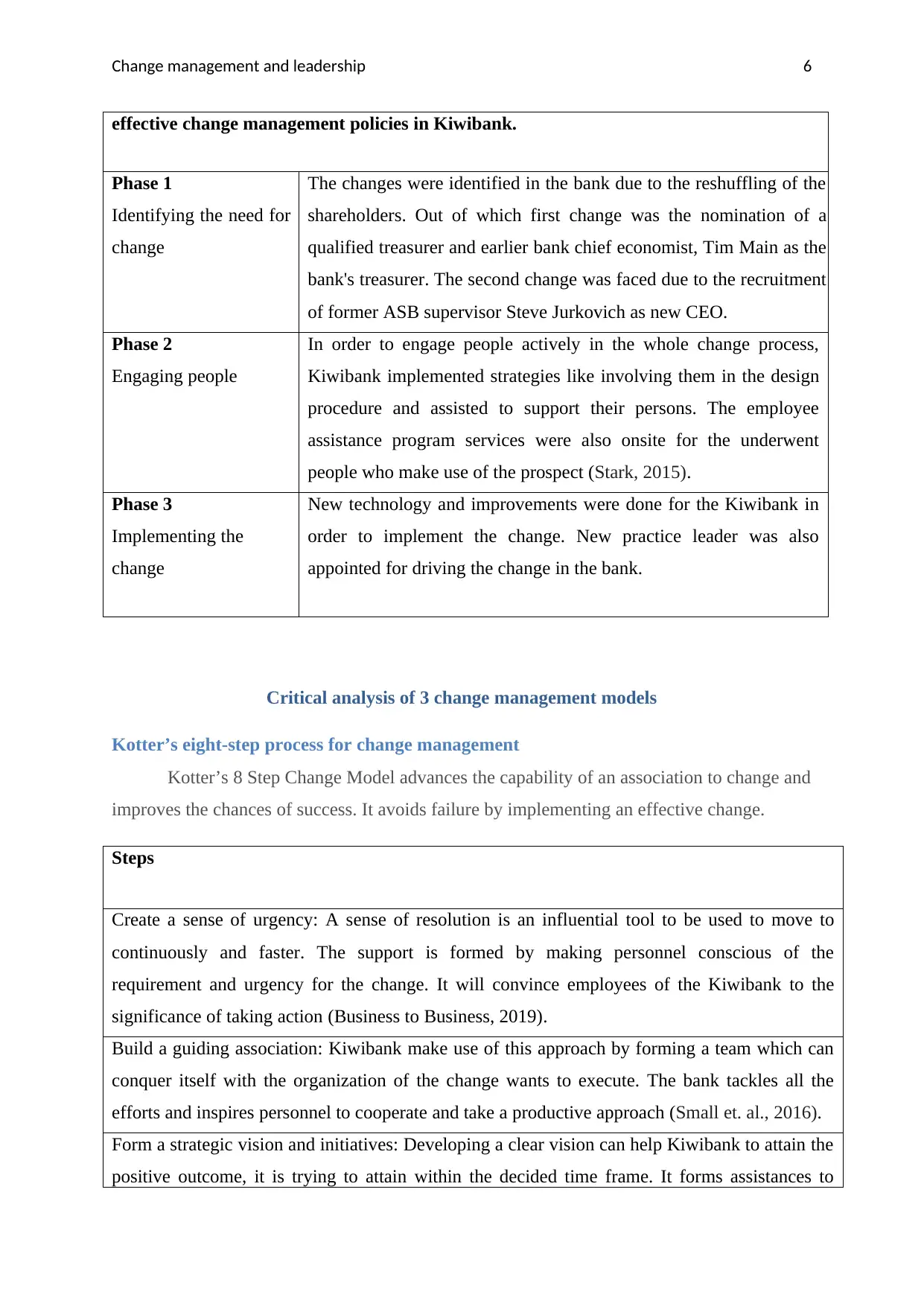
Change management and leadership 6
effective change management policies in Kiwibank.
Phase 1
Identifying the need for
change
The changes were identified in the bank due to the reshuffling of the
shareholders. Out of which first change was the nomination of a
qualified treasurer and earlier bank chief economist, Tim Main as the
bank's treasurer. The second change was faced due to the recruitment
of former ASB supervisor Steve Jurkovich as new CEO.
Phase 2
Engaging people
In order to engage people actively in the whole change process,
Kiwibank implemented strategies like involving them in the design
procedure and assisted to support their persons. The employee
assistance program services were also onsite for the underwent
people who make use of the prospect (Stark, 2015).
Phase 3
Implementing the
change
New technology and improvements were done for the Kiwibank in
order to implement the change. New practice leader was also
appointed for driving the change in the bank.
Critical analysis of 3 change management models
Kotter’s eight-step process for change management
Kotter’s 8 Step Change Model advances the capability of an association to change and
improves the chances of success. It avoids failure by implementing an effective change.
Steps
Create a sense of urgency: A sense of resolution is an influential tool to be used to move to
continuously and faster. The support is formed by making personnel conscious of the
requirement and urgency for the change. It will convince employees of the Kiwibank to the
significance of taking action (Business to Business, 2019).
Build a guiding association: Kiwibank make use of this approach by forming a team which can
conquer itself with the organization of the change wants to execute. The bank tackles all the
efforts and inspires personnel to cooperate and take a productive approach (Small et. al., 2016).
Form a strategic vision and initiatives: Developing a clear vision can help Kiwibank to attain the
positive outcome, it is trying to attain within the decided time frame. It forms assistances to
effective change management policies in Kiwibank.
Phase 1
Identifying the need for
change
The changes were identified in the bank due to the reshuffling of the
shareholders. Out of which first change was the nomination of a
qualified treasurer and earlier bank chief economist, Tim Main as the
bank's treasurer. The second change was faced due to the recruitment
of former ASB supervisor Steve Jurkovich as new CEO.
Phase 2
Engaging people
In order to engage people actively in the whole change process,
Kiwibank implemented strategies like involving them in the design
procedure and assisted to support their persons. The employee
assistance program services were also onsite for the underwent
people who make use of the prospect (Stark, 2015).
Phase 3
Implementing the
change
New technology and improvements were done for the Kiwibank in
order to implement the change. New practice leader was also
appointed for driving the change in the bank.
Critical analysis of 3 change management models
Kotter’s eight-step process for change management
Kotter’s 8 Step Change Model advances the capability of an association to change and
improves the chances of success. It avoids failure by implementing an effective change.
Steps
Create a sense of urgency: A sense of resolution is an influential tool to be used to move to
continuously and faster. The support is formed by making personnel conscious of the
requirement and urgency for the change. It will convince employees of the Kiwibank to the
significance of taking action (Business to Business, 2019).
Build a guiding association: Kiwibank make use of this approach by forming a team which can
conquer itself with the organization of the change wants to execute. The bank tackles all the
efforts and inspires personnel to cooperate and take a productive approach (Small et. al., 2016).
Form a strategic vision and initiatives: Developing a clear vision can help Kiwibank to attain the
positive outcome, it is trying to attain within the decided time frame. It forms assistances to
Paraphrase This Document
Need a fresh take? Get an instant paraphrase of this document with our AI Paraphraser
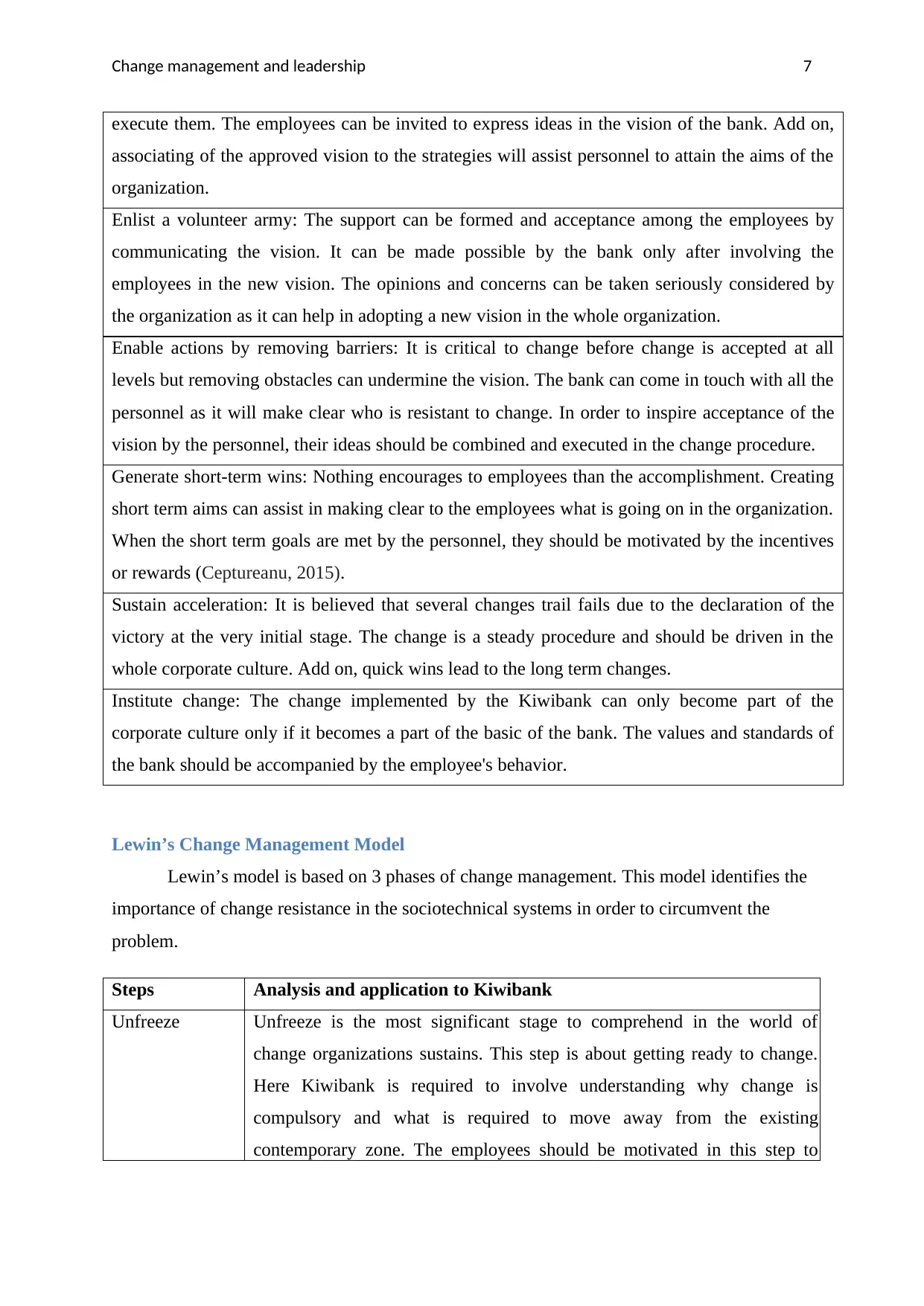
Change management and leadership 7
execute them. The employees can be invited to express ideas in the vision of the bank. Add on,
associating of the approved vision to the strategies will assist personnel to attain the aims of the
organization.
Enlist a volunteer army: The support can be formed and acceptance among the employees by
communicating the vision. It can be made possible by the bank only after involving the
employees in the new vision. The opinions and concerns can be taken seriously considered by
the organization as it can help in adopting a new vision in the whole organization.
Enable actions by removing barriers: It is critical to change before change is accepted at all
levels but removing obstacles can undermine the vision. The bank can come in touch with all the
personnel as it will make clear who is resistant to change. In order to inspire acceptance of the
vision by the personnel, their ideas should be combined and executed in the change procedure.
Generate short-term wins: Nothing encourages to employees than the accomplishment. Creating
short term aims can assist in making clear to the employees what is going on in the organization.
When the short term goals are met by the personnel, they should be motivated by the incentives
or rewards (Ceptureanu, 2015).
Sustain acceleration: It is believed that several changes trail fails due to the declaration of the
victory at the very initial stage. The change is a steady procedure and should be driven in the
whole corporate culture. Add on, quick wins lead to the long term changes.
Institute change: The change implemented by the Kiwibank can only become part of the
corporate culture only if it becomes a part of the basic of the bank. The values and standards of
the bank should be accompanied by the employee's behavior.
Lewin’s Change Management Model
Lewin’s model is based on 3 phases of change management. This model identifies the
importance of change resistance in the sociotechnical systems in order to circumvent the
problem.
Steps Analysis and application to Kiwibank
Unfreeze Unfreeze is the most significant stage to comprehend in the world of
change organizations sustains. This step is about getting ready to change.
Here Kiwibank is required to involve understanding why change is
compulsory and what is required to move away from the existing
contemporary zone. The employees should be motivated in this step to
execute them. The employees can be invited to express ideas in the vision of the bank. Add on,
associating of the approved vision to the strategies will assist personnel to attain the aims of the
organization.
Enlist a volunteer army: The support can be formed and acceptance among the employees by
communicating the vision. It can be made possible by the bank only after involving the
employees in the new vision. The opinions and concerns can be taken seriously considered by
the organization as it can help in adopting a new vision in the whole organization.
Enable actions by removing barriers: It is critical to change before change is accepted at all
levels but removing obstacles can undermine the vision. The bank can come in touch with all the
personnel as it will make clear who is resistant to change. In order to inspire acceptance of the
vision by the personnel, their ideas should be combined and executed in the change procedure.
Generate short-term wins: Nothing encourages to employees than the accomplishment. Creating
short term aims can assist in making clear to the employees what is going on in the organization.
When the short term goals are met by the personnel, they should be motivated by the incentives
or rewards (Ceptureanu, 2015).
Sustain acceleration: It is believed that several changes trail fails due to the declaration of the
victory at the very initial stage. The change is a steady procedure and should be driven in the
whole corporate culture. Add on, quick wins lead to the long term changes.
Institute change: The change implemented by the Kiwibank can only become part of the
corporate culture only if it becomes a part of the basic of the bank. The values and standards of
the bank should be accompanied by the employee's behavior.
Lewin’s Change Management Model
Lewin’s model is based on 3 phases of change management. This model identifies the
importance of change resistance in the sociotechnical systems in order to circumvent the
problem.
Steps Analysis and application to Kiwibank
Unfreeze Unfreeze is the most significant stage to comprehend in the world of
change organizations sustains. This step is about getting ready to change.
Here Kiwibank is required to involve understanding why change is
compulsory and what is required to move away from the existing
contemporary zone. The employees should be motivated in this step to
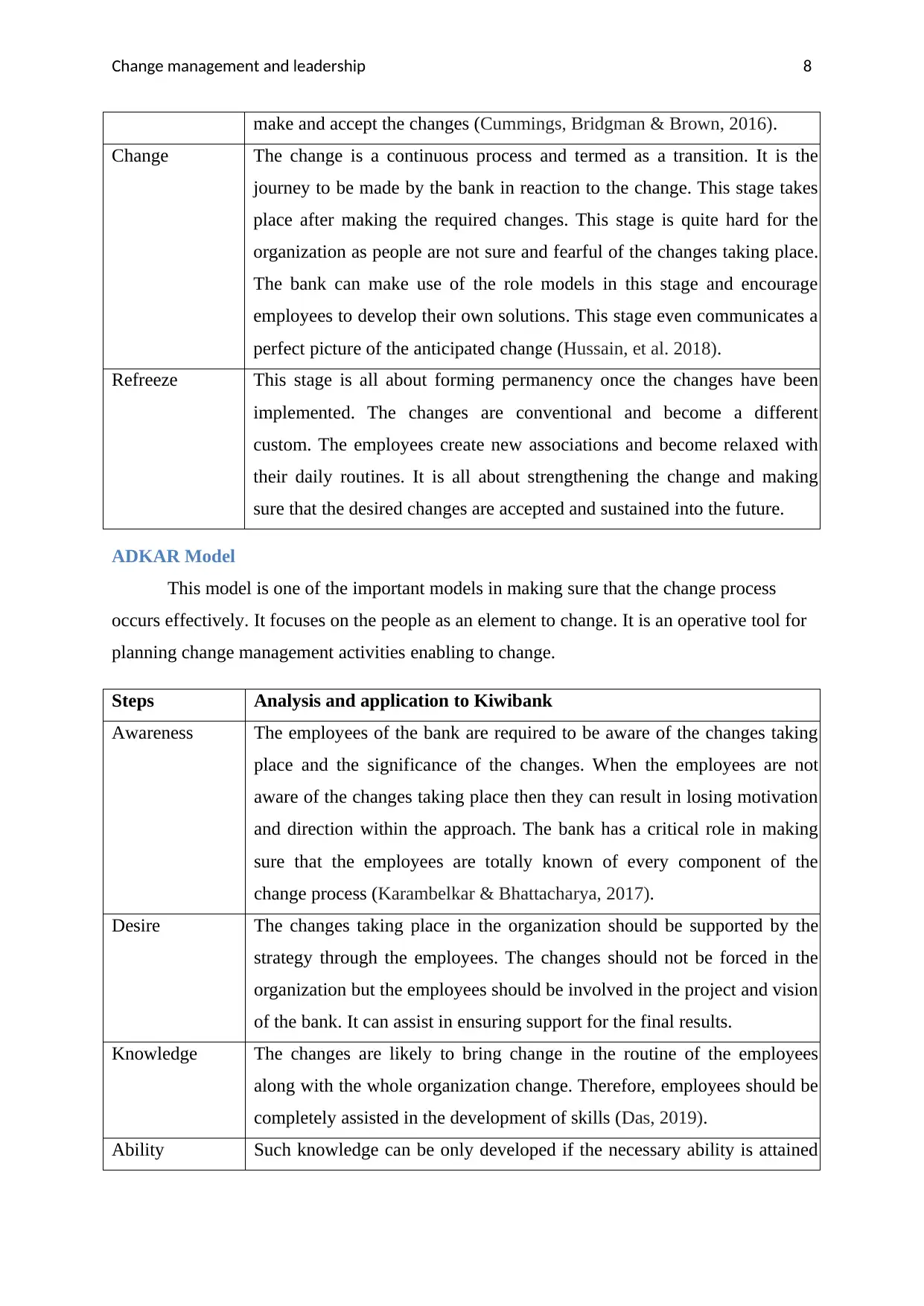
Change management and leadership 8
make and accept the changes (Cummings, Bridgman & Brown, 2016).
Change The change is a continuous process and termed as a transition. It is the
journey to be made by the bank in reaction to the change. This stage takes
place after making the required changes. This stage is quite hard for the
organization as people are not sure and fearful of the changes taking place.
The bank can make use of the role models in this stage and encourage
employees to develop their own solutions. This stage even communicates a
perfect picture of the anticipated change (Hussain, et al. 2018).
Refreeze This stage is all about forming permanency once the changes have been
implemented. The changes are conventional and become a different
custom. The employees create new associations and become relaxed with
their daily routines. It is all about strengthening the change and making
sure that the desired changes are accepted and sustained into the future.
ADKAR Model
This model is one of the important models in making sure that the change process
occurs effectively. It focuses on the people as an element to change. It is an operative tool for
planning change management activities enabling to change.
Steps Analysis and application to Kiwibank
Awareness The employees of the bank are required to be aware of the changes taking
place and the significance of the changes. When the employees are not
aware of the changes taking place then they can result in losing motivation
and direction within the approach. The bank has a critical role in making
sure that the employees are totally known of every component of the
change process (Karambelkar & Bhattacharya, 2017).
Desire The changes taking place in the organization should be supported by the
strategy through the employees. The changes should not be forced in the
organization but the employees should be involved in the project and vision
of the bank. It can assist in ensuring support for the final results.
Knowledge The changes are likely to bring change in the routine of the employees
along with the whole organization change. Therefore, employees should be
completely assisted in the development of skills (Das, 2019).
Ability Such knowledge can be only developed if the necessary ability is attained
make and accept the changes (Cummings, Bridgman & Brown, 2016).
Change The change is a continuous process and termed as a transition. It is the
journey to be made by the bank in reaction to the change. This stage takes
place after making the required changes. This stage is quite hard for the
organization as people are not sure and fearful of the changes taking place.
The bank can make use of the role models in this stage and encourage
employees to develop their own solutions. This stage even communicates a
perfect picture of the anticipated change (Hussain, et al. 2018).
Refreeze This stage is all about forming permanency once the changes have been
implemented. The changes are conventional and become a different
custom. The employees create new associations and become relaxed with
their daily routines. It is all about strengthening the change and making
sure that the desired changes are accepted and sustained into the future.
ADKAR Model
This model is one of the important models in making sure that the change process
occurs effectively. It focuses on the people as an element to change. It is an operative tool for
planning change management activities enabling to change.
Steps Analysis and application to Kiwibank
Awareness The employees of the bank are required to be aware of the changes taking
place and the significance of the changes. When the employees are not
aware of the changes taking place then they can result in losing motivation
and direction within the approach. The bank has a critical role in making
sure that the employees are totally known of every component of the
change process (Karambelkar & Bhattacharya, 2017).
Desire The changes taking place in the organization should be supported by the
strategy through the employees. The changes should not be forced in the
organization but the employees should be involved in the project and vision
of the bank. It can assist in ensuring support for the final results.
Knowledge The changes are likely to bring change in the routine of the employees
along with the whole organization change. Therefore, employees should be
completely assisted in the development of skills (Das, 2019).
Ability Such knowledge can be only developed if the necessary ability is attained
⊘ This is a preview!⊘
Do you want full access?
Subscribe today to unlock all pages.

Trusted by 1+ million students worldwide
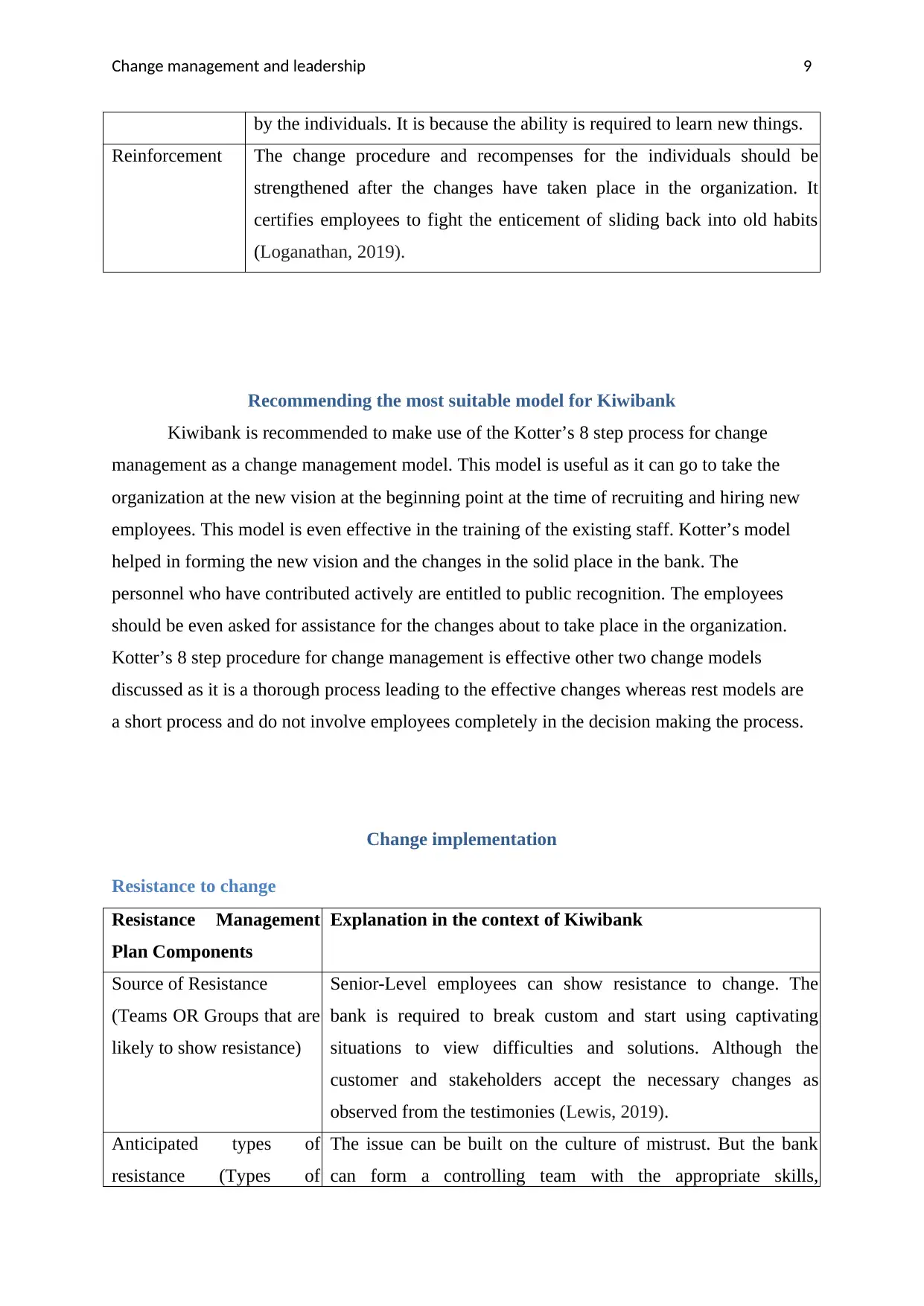
Change management and leadership 9
by the individuals. It is because the ability is required to learn new things.
Reinforcement The change procedure and recompenses for the individuals should be
strengthened after the changes have taken place in the organization. It
certifies employees to fight the enticement of sliding back into old habits
(Loganathan, 2019).
Recommending the most suitable model for Kiwibank
Kiwibank is recommended to make use of the Kotter’s 8 step process for change
management as a change management model. This model is useful as it can go to take the
organization at the new vision at the beginning point at the time of recruiting and hiring new
employees. This model is even effective in the training of the existing staff. Kotter’s model
helped in forming the new vision and the changes in the solid place in the bank. The
personnel who have contributed actively are entitled to public recognition. The employees
should be even asked for assistance for the changes about to take place in the organization.
Kotter’s 8 step procedure for change management is effective other two change models
discussed as it is a thorough process leading to the effective changes whereas rest models are
a short process and do not involve employees completely in the decision making the process.
Change implementation
Resistance to change
Resistance Management
Plan Components
Explanation in the context of Kiwibank
Source of Resistance
(Teams OR Groups that are
likely to show resistance)
Senior-Level employees can show resistance to change. The
bank is required to break custom and start using captivating
situations to view difficulties and solutions. Although the
customer and stakeholders accept the necessary changes as
observed from the testimonies (Lewis, 2019).
Anticipated types of
resistance (Types of
The issue can be built on the culture of mistrust. But the bank
can form a controlling team with the appropriate skills,
by the individuals. It is because the ability is required to learn new things.
Reinforcement The change procedure and recompenses for the individuals should be
strengthened after the changes have taken place in the organization. It
certifies employees to fight the enticement of sliding back into old habits
(Loganathan, 2019).
Recommending the most suitable model for Kiwibank
Kiwibank is recommended to make use of the Kotter’s 8 step process for change
management as a change management model. This model is useful as it can go to take the
organization at the new vision at the beginning point at the time of recruiting and hiring new
employees. This model is even effective in the training of the existing staff. Kotter’s model
helped in forming the new vision and the changes in the solid place in the bank. The
personnel who have contributed actively are entitled to public recognition. The employees
should be even asked for assistance for the changes about to take place in the organization.
Kotter’s 8 step procedure for change management is effective other two change models
discussed as it is a thorough process leading to the effective changes whereas rest models are
a short process and do not involve employees completely in the decision making the process.
Change implementation
Resistance to change
Resistance Management
Plan Components
Explanation in the context of Kiwibank
Source of Resistance
(Teams OR Groups that are
likely to show resistance)
Senior-Level employees can show resistance to change. The
bank is required to break custom and start using captivating
situations to view difficulties and solutions. Although the
customer and stakeholders accept the necessary changes as
observed from the testimonies (Lewis, 2019).
Anticipated types of
resistance (Types of
The issue can be built on the culture of mistrust. But the bank
can form a controlling team with the appropriate skills,
Paraphrase This Document
Need a fresh take? Get an instant paraphrase of this document with our AI Paraphraser
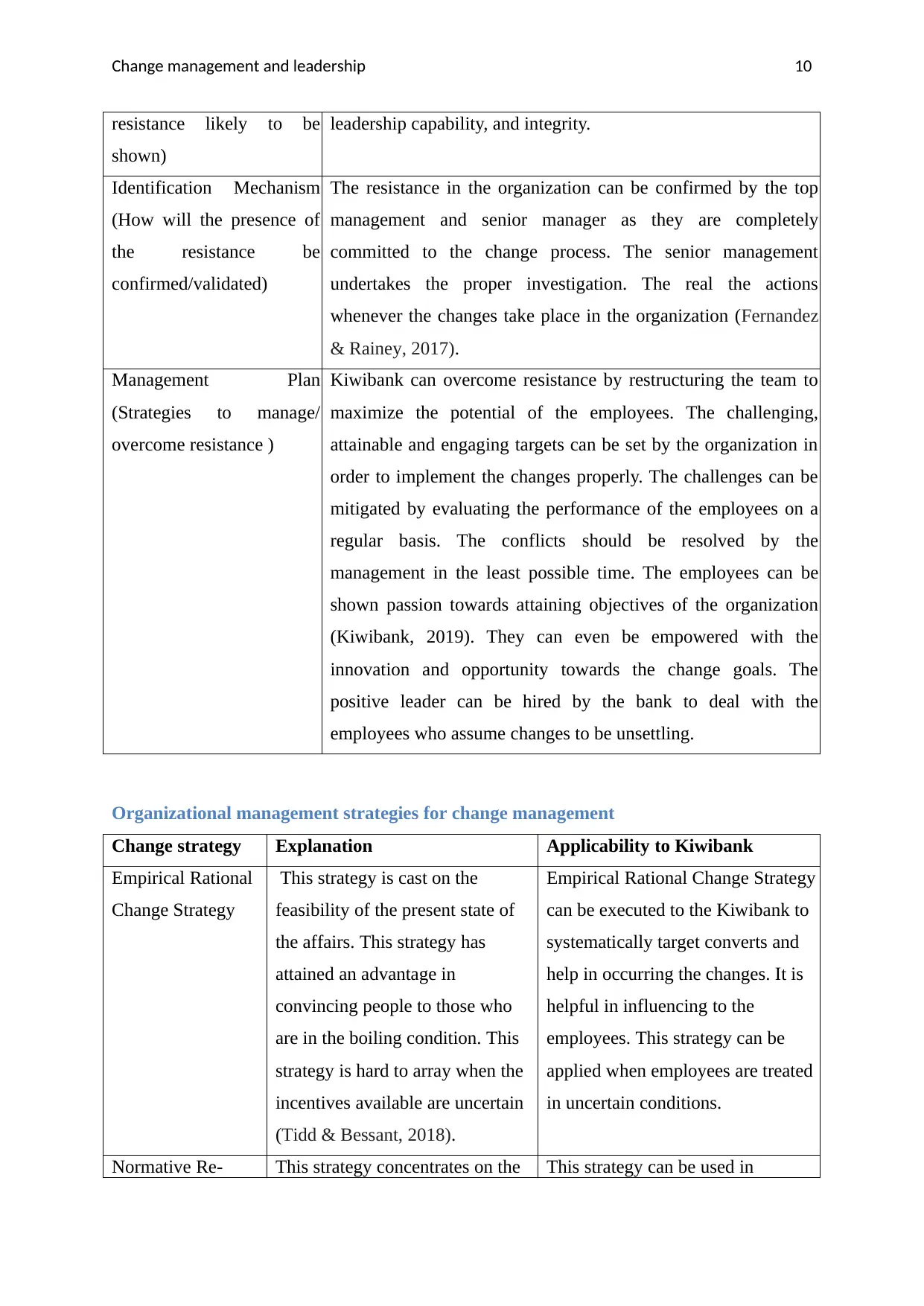
Change management and leadership 10
resistance likely to be
shown)
leadership capability, and integrity.
Identification Mechanism
(How will the presence of
the resistance be
confirmed/validated)
The resistance in the organization can be confirmed by the top
management and senior manager as they are completely
committed to the change process. The senior management
undertakes the proper investigation. The real the actions
whenever the changes take place in the organization (Fernandez
& Rainey, 2017).
Management Plan
(Strategies to manage/
overcome resistance )
Kiwibank can overcome resistance by restructuring the team to
maximize the potential of the employees. The challenging,
attainable and engaging targets can be set by the organization in
order to implement the changes properly. The challenges can be
mitigated by evaluating the performance of the employees on a
regular basis. The conflicts should be resolved by the
management in the least possible time. The employees can be
shown passion towards attaining objectives of the organization
(Kiwibank, 2019). They can even be empowered with the
innovation and opportunity towards the change goals. The
positive leader can be hired by the bank to deal with the
employees who assume changes to be unsettling.
Organizational management strategies for change management
Change strategy Explanation Applicability to Kiwibank
Empirical Rational
Change Strategy
This strategy is cast on the
feasibility of the present state of
the affairs. This strategy has
attained an advantage in
convincing people to those who
are in the boiling condition. This
strategy is hard to array when the
incentives available are uncertain
(Tidd & Bessant, 2018).
Empirical Rational Change Strategy
can be executed to the Kiwibank to
systematically target converts and
help in occurring the changes. It is
helpful in influencing to the
employees. This strategy can be
applied when employees are treated
in uncertain conditions.
Normative Re- This strategy concentrates on the This strategy can be used in
resistance likely to be
shown)
leadership capability, and integrity.
Identification Mechanism
(How will the presence of
the resistance be
confirmed/validated)
The resistance in the organization can be confirmed by the top
management and senior manager as they are completely
committed to the change process. The senior management
undertakes the proper investigation. The real the actions
whenever the changes take place in the organization (Fernandez
& Rainey, 2017).
Management Plan
(Strategies to manage/
overcome resistance )
Kiwibank can overcome resistance by restructuring the team to
maximize the potential of the employees. The challenging,
attainable and engaging targets can be set by the organization in
order to implement the changes properly. The challenges can be
mitigated by evaluating the performance of the employees on a
regular basis. The conflicts should be resolved by the
management in the least possible time. The employees can be
shown passion towards attaining objectives of the organization
(Kiwibank, 2019). They can even be empowered with the
innovation and opportunity towards the change goals. The
positive leader can be hired by the bank to deal with the
employees who assume changes to be unsettling.
Organizational management strategies for change management
Change strategy Explanation Applicability to Kiwibank
Empirical Rational
Change Strategy
This strategy is cast on the
feasibility of the present state of
the affairs. This strategy has
attained an advantage in
convincing people to those who
are in the boiling condition. This
strategy is hard to array when the
incentives available are uncertain
(Tidd & Bessant, 2018).
Empirical Rational Change Strategy
can be executed to the Kiwibank to
systematically target converts and
help in occurring the changes. It is
helpful in influencing to the
employees. This strategy can be
applied when employees are treated
in uncertain conditions.
Normative Re- This strategy concentrates on the This strategy can be used in
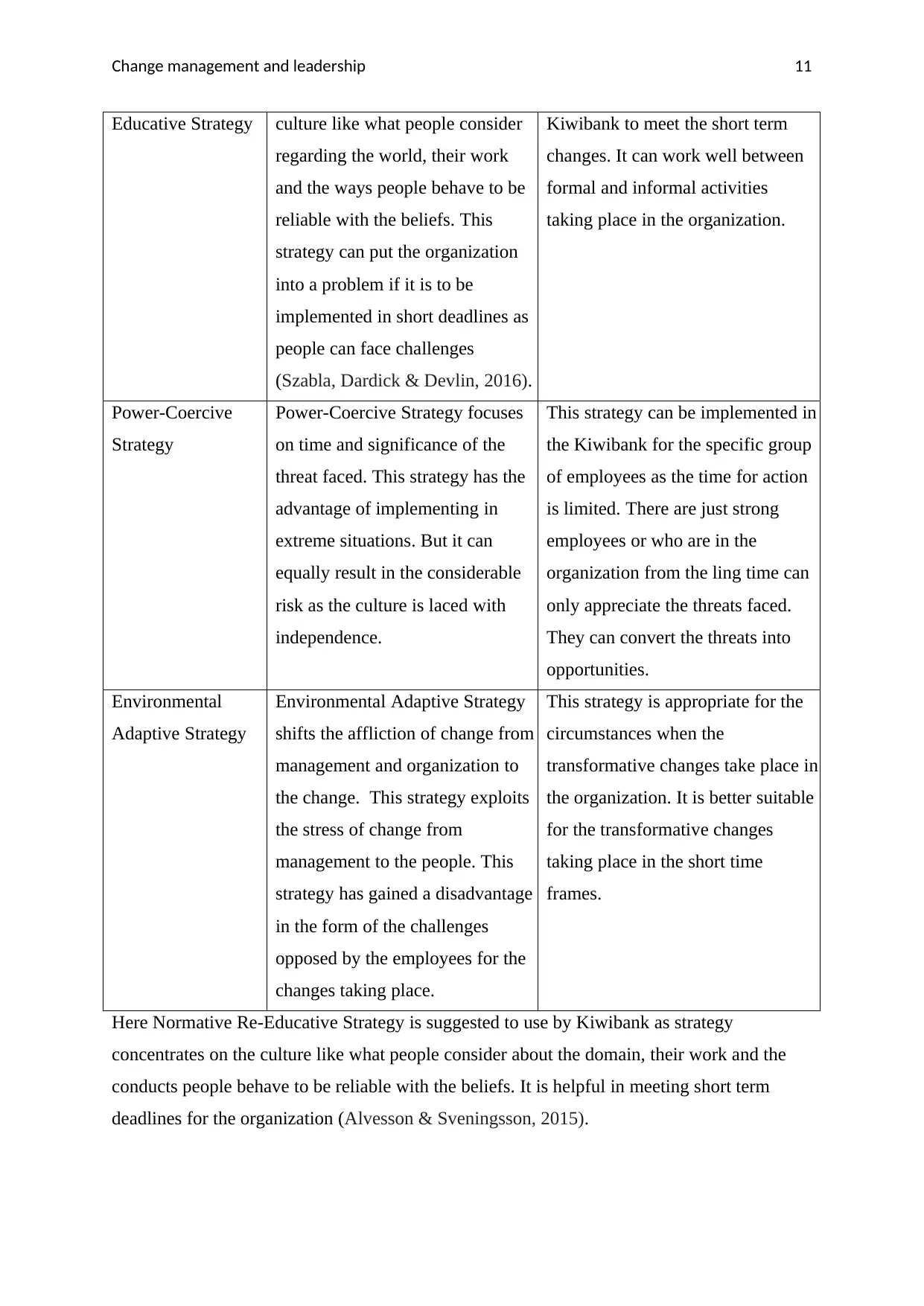
Change management and leadership 11
Educative Strategy culture like what people consider
regarding the world, their work
and the ways people behave to be
reliable with the beliefs. This
strategy can put the organization
into a problem if it is to be
implemented in short deadlines as
people can face challenges
(Szabla, Dardick & Devlin, 2016).
Kiwibank to meet the short term
changes. It can work well between
formal and informal activities
taking place in the organization.
Power-Coercive
Strategy
Power-Coercive Strategy focuses
on time and significance of the
threat faced. This strategy has the
advantage of implementing in
extreme situations. But it can
equally result in the considerable
risk as the culture is laced with
independence.
This strategy can be implemented in
the Kiwibank for the specific group
of employees as the time for action
is limited. There are just strong
employees or who are in the
organization from the ling time can
only appreciate the threats faced.
They can convert the threats into
opportunities.
Environmental
Adaptive Strategy
Environmental Adaptive Strategy
shifts the affliction of change from
management and organization to
the change. This strategy exploits
the stress of change from
management to the people. This
strategy has gained a disadvantage
in the form of the challenges
opposed by the employees for the
changes taking place.
This strategy is appropriate for the
circumstances when the
transformative changes take place in
the organization. It is better suitable
for the transformative changes
taking place in the short time
frames.
Here Normative Re-Educative Strategy is suggested to use by Kiwibank as strategy
concentrates on the culture like what people consider about the domain, their work and the
conducts people behave to be reliable with the beliefs. It is helpful in meeting short term
deadlines for the organization (Alvesson & Sveningsson, 2015).
Educative Strategy culture like what people consider
regarding the world, their work
and the ways people behave to be
reliable with the beliefs. This
strategy can put the organization
into a problem if it is to be
implemented in short deadlines as
people can face challenges
(Szabla, Dardick & Devlin, 2016).
Kiwibank to meet the short term
changes. It can work well between
formal and informal activities
taking place in the organization.
Power-Coercive
Strategy
Power-Coercive Strategy focuses
on time and significance of the
threat faced. This strategy has the
advantage of implementing in
extreme situations. But it can
equally result in the considerable
risk as the culture is laced with
independence.
This strategy can be implemented in
the Kiwibank for the specific group
of employees as the time for action
is limited. There are just strong
employees or who are in the
organization from the ling time can
only appreciate the threats faced.
They can convert the threats into
opportunities.
Environmental
Adaptive Strategy
Environmental Adaptive Strategy
shifts the affliction of change from
management and organization to
the change. This strategy exploits
the stress of change from
management to the people. This
strategy has gained a disadvantage
in the form of the challenges
opposed by the employees for the
changes taking place.
This strategy is appropriate for the
circumstances when the
transformative changes take place in
the organization. It is better suitable
for the transformative changes
taking place in the short time
frames.
Here Normative Re-Educative Strategy is suggested to use by Kiwibank as strategy
concentrates on the culture like what people consider about the domain, their work and the
conducts people behave to be reliable with the beliefs. It is helpful in meeting short term
deadlines for the organization (Alvesson & Sveningsson, 2015).
⊘ This is a preview!⊘
Do you want full access?
Subscribe today to unlock all pages.

Trusted by 1+ million students worldwide
1 out of 23
Related Documents
Your All-in-One AI-Powered Toolkit for Academic Success.
+13062052269
info@desklib.com
Available 24*7 on WhatsApp / Email
![[object Object]](/_next/static/media/star-bottom.7253800d.svg)
Unlock your academic potential
Copyright © 2020–2025 A2Z Services. All Rights Reserved. Developed and managed by ZUCOL.





